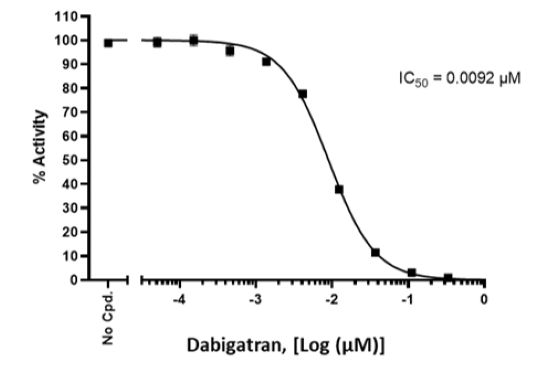Thrombin Inhibitor Screening Assay Kit
The Thrombin Inhibitor Screening Assay is a colorimetric assay designed to measure the activity of human alpha thrombin for screening and profiling applications. The assay kit comes in a convenient 96-well or 384-well format and contains enough purified human alpha thrombin, a chromogenic substrate, and PR-02 buffer for 100 or 400 reactions.
To determine the effect of an inhibitor on Thrombin activity, the enzyme should be preincubated with or without the test inhibitor prior to adding the chromogenic substrate to the reaction. The assay was functionally validated using Dabigatran, a potent inhibitor of thrombin.

Figure 1: Illustration of the assay principle.
Upon proteolysis, thrombin cleaves the chromogenic substrate at the C-terminal end releasing p-nitroanilid (pNA), which produces a yellow color that is measurable photometrically at λ=405 nm. The increase in color is proportional to thrombin activity.
- UV/Vis Microplate reader capable of reading λ=405 nm
- Rotating or rocker platform
96 reactions
| Catalog # | Name | Amount | Storage |
| Human alpha thrombin* | 5 µg | -80°C | |
| PR Substrate 2 | 50 µl | -80°C | |
| PR-02 Buffer | 10 ml | -80°C | |
| 96-well clear microplate | 1 | Room Temp |
* The concentration of protein is lot-specific and will be indicated on the tube containing the protein.
384 reactions
| Catalog # | Name | Amount | Storage |
| Human alpha thrombin* | 2 x 5 µg | -80°C | |
| PR Substrate 2 | 2 x 50 µl | -80°C | |
| PR-02 Buffer | 2 x 10 ml | -80°C | |
| 384-well clear microplate | 1 | Room Temp |
* The concentration of protein is lot-specific and will be indicated on the tube containing the protein.
Thrombin (also known as factor IIa, activated blood-coagulation factor II, EC 3.4.21.5 or fibrogenase) is a serine protease crucial for blood coagulation. Thrombin is synthetized in the inactive form prothrombin, and it is cleaved by activated Factor X (Xa). It activates factor XI, VIII, V XIII, and converts fibrinogen to fibrin by cleaving fibrinogen chains into monomers. Activated factor XIII (XIIIa) increases the stability of the clot by forming covalent bonds between fibrin molecules. In addition, thrombin leads to platelet activation and aggregation. Interestingly, thrombin is also involved in a negative feedback mechanism, by acting as an inhibitor of the coagulation cascade when bound to thrombomodulin. Thrombin is involved in the formation of blood clots in arteries, which can result in cerebral ischemia and stroke. It is also involved in atherosclerosis via angiogenesis (vascular cell recruitment to the plaque), and inflammation. The use of small molecule inhibitors for thrombin is a viable therapy in cardiovascular complications



